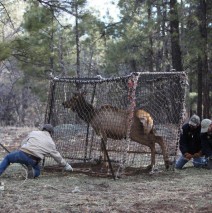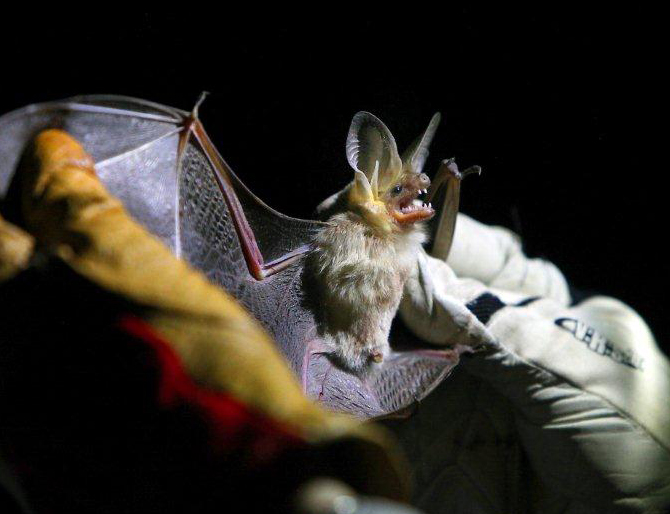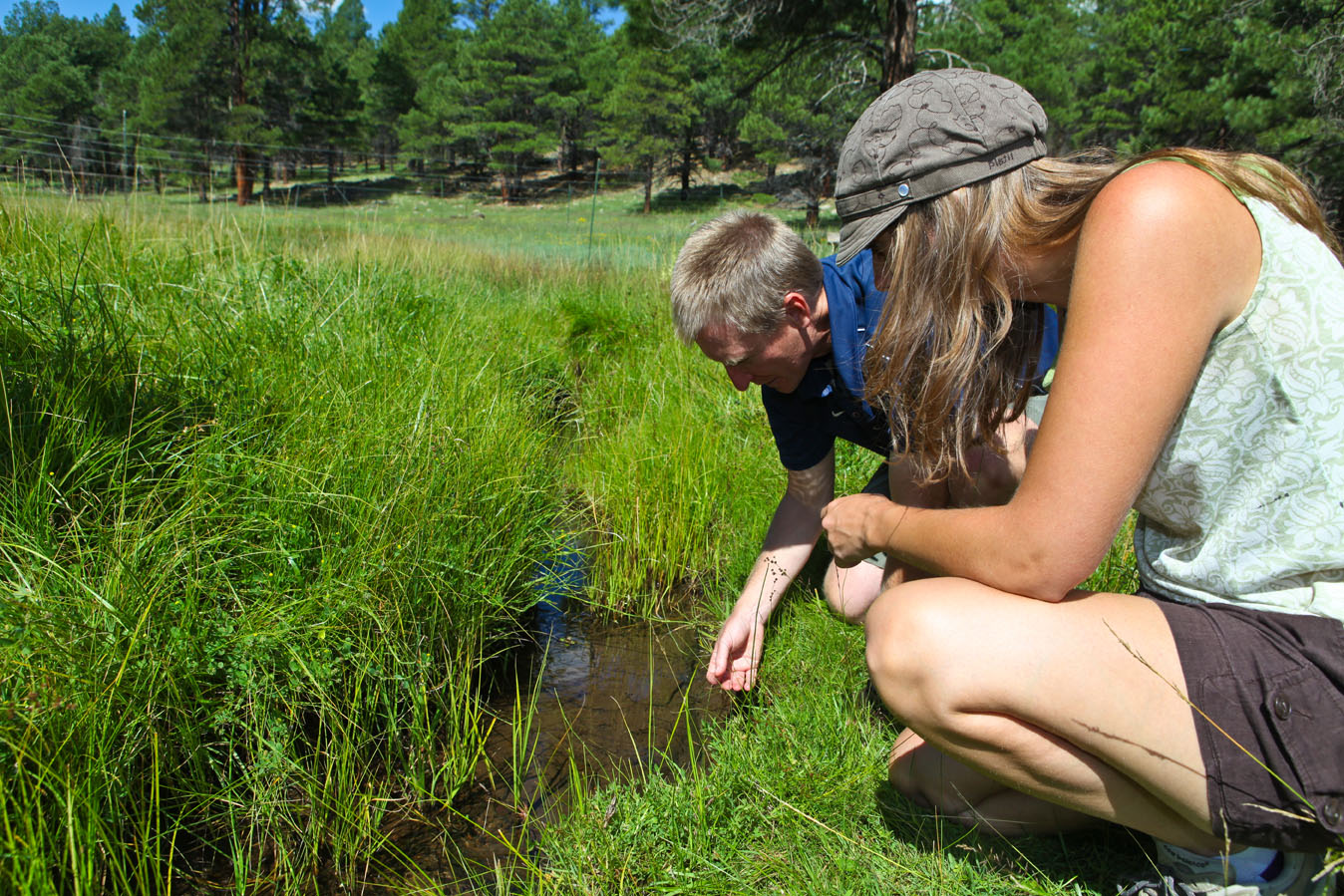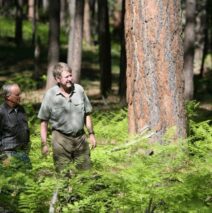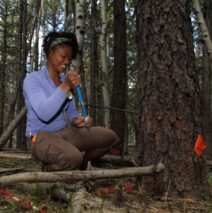Northern Arizona Elk Getting The Collar
Elk are roaming around the woods with collars around their necks. In the forest near Flagstaff, elk are being outfitted to tell researchers what they and other animals need to navigate through urban sprawl, climate change and large restoration projects. For Arizona Game and Fish Department wildlife biologist Jeff Gagnon, the job of collaring an elk is somewhat like a rodeo event. Within minutes, he and a team of wildlife managers can calm a frightened animal that might weigh as much as a thousand pounds. "We fit the collar to make sure the animal has some space and isn't being choked," he says. The collar is programmed to fall off in a few months. But in the meantime, every two hours a GPS unit is sending signals to satellites that are sending signals to biologists. Gagnon has been tracking some 130 elk around major highways, including interstates 17 and 40. "We know where the animals are, what kind of habitat they are using and what barriers are stopping them. For a lot of animals when we fragment their habitat, they can't get to resources like summer or winter range. We also run the risk of isolating or breaking up the herd, which can lead to a smaller gene pool and a weaker species." Researchers like Northern Arizona University's Paul Beier, a conservation biology and wildlife ecology professor in the School of Forestry, says this information is critically important to keep animals from stepping into danger or even extinction. "With climate change, we have the situation where habitat is literally moving out from under the feet of wildlife," he says. "In order for these species to stay where they are, in terms of a healthy population, they have to move." Beier is developing maps detailing links for wild areas, or wildlife corridors, to help land managers understand how animals move across the land. "We're creating landscapes that are more permeable than the landscapes we had a decade or two decades ago," he says. "If you provide habitat for the large species, you bring the others along," says Arizona Game and Fish Department Habitat Program Manager Sarah Reif. "Elk, mule deer, pronghorn antelope -- these are the big guys we manage for because of public safety on highways and roads, and because they have the biggest home ranges." Pronghorn have long been a symbol of the West, but researchers say barriers like canals, fences and highways have had a substantial impact on the population. "In Arizona, the numbers declined from about 45,000 animals in the early 1900s to roughly 7,500 in 2002," says Reif. "Since then, we have recovered the population to somewhere around 11,000 but we still have a lot of work to do to connect pronghorn habitats." With information about wildlife movement, highways are becoming less of a hindrance, and safer for wildlife and people. Groups like the Arizona Department of Transportation, Elk Society, Rocky Mountain Elk Foundation and Federal Highway Administration are funding research and passageways. For example, along State Route 260 near Payson, highway improvement projects have included wildlife elevated crossings. "Animals are using the crossings," says Gagnon, "and collisions between elk and motorists have been reduced by at least 85 percent." Wally Covington, executive director of the Ecological Restoration Institute at NAU, says managing for wildlife corridors is increasingly important as forests are restored on a landscape scale. "Across hundreds of thousands of acres, natural habitat can be restored. Wildlife can self-regulate. Predator-prey dynamics can keep populations in a sustainable, steady state that's characteristic of the evolutionary environment." Wearing high-tech necklaces, today's elk may well be...
Read MoreBats Offered Alternative to Haunted Houses
Bats Offered Alternative to Haunted Houses This time of year we often associate bats with haunted houses, but houses don’t have to be haunted to attract these creatures of the night. Wildlife biologists say the large, standing dead ponderosa pine trees that many bats prefer are not abundant in our Southwestern forests anymore. So instead of crawling under the loose bark of snags to roost or raise their young, bats may be choosing to live with you, under the eaves of your home. To solve this shortage-in-bat-housing problem, Northern Arizona University School of Forestry graduate student Liz Mering is introducing bat condominiums to the forest neighborhood. “We have two kinds of artificial roosts that mount onto the trunks of large trees and mimic the exfoliating-bark characteristics of dead, old ponderosas pines. One is made of wood and looks like a one-foot by one-foot wedged box. The other is made of resin. It’s molded and painted to look like bark.” Mering has posted 104 artificial roosts in trees around Flagstaff in the last two years. Half are wooden; half are resin. She says it’s too early to tell which kind the bats like better, but wildlife biologists prefer the resin roosts. They are made of the same material you find in boats, so they’re durable, lasting as long as the bats themselves, up to 30 years in the woods. And because they look so much like the bark of a ponderosa pine, they are fooling both the bats and their predators. Unfortunately, they are also expensive, about $50 each. Noting the importance of bats in the ecosystem, the Forest Service has purchased 50 of these to ofer bats more habitat. “Bats have gotten a bad reputation because people often associate them with rabies,” says Red Rock Ranger District Wildlife Biologist Janie Agyagos. “But less than half of 1 percent of the bat population actually carries the rabies virus. Instead, bats provide many benefits to the forest.” Those benefits include fertilizing the soil with their guano, pollinating certain plants, and the big one, eating a lot of insects. Of the 28 bat species squeaking and echo-locating across Arizona’s dark skies, 20 different kinds live in northern Arizona. Most weigh less than half a Hershey’s chocolate bar, but these ravenous nocturnal creatures are eating far more than their weight in pests. “One bat can eat 600 mosquitos in an hour,” says Agyagos. “The desert pallid bat found in Sedona can pick up scorpions and millipedes off the ground and fly away with them.” Keeping up with that appetite is exhausting, so finding a safe place to rest is critical to the bats’survival. “We have a lot of trees in the forest, but not a lot of big trees,” says NAU School of Forestry Wildlife Ecology Professor Dr. Carol Chambers. “The bats we are studying are using trees with 25- to 30- inch diameters. With human-caused changes to the forest structure during the last century, we don’t have as many big, old trees as we once did, trees that will die and become bat habitat. While forest restoration efforts eventually will result in more big old trees, we’re hoping to be able to provide viable bat habitat in the meantime.” By attaching a large bag that looks like a wind sock to the bat boxes, Mering is able to briefly capture the bats when they leave the roosts and examine them for disease and gender. “We’ve gotten a lot of use based on mostly non-reproductive single bats. We’re hoping in a few more years we’ll get more use as many bats find them and remember them.” If female bats set up maternity colonies and begin raising their pups in the artificial bat homes, researchers say they’ll have found a...
Read MoreReturning the Wet to Wetlands
Most of us would simply call it mud, but to wetland biologists, dark messy, sloshy soil is as good as gold in the arid Southwest, oozing with organically rich potential. Early settlers found a lot of it. They described pools of water, knee-deep grasses, narrow streams and fertile soil as they passed through Arizona’s high country. But scientists are concerned that many of our seeps and springs are drying up. While plotting a route from Arkansas to California in 1857, Navy Lieutenant Edward Fitzgerald Beale raved about the fresh water and lush vegetation of the Little Colorado River near Winslow. “The soil seems fertile and bears good meadow grass in all parts,” he wrote, “while the plains, extending from its banks as far as one can see, are covered with rich grama grass.” A visit there today might make you wonder if Beale had been trotting his camels across some other territory. Now 50 percent of what the Little Colorado holds is silt and much of its banks are stripped of native vegetation. After wading through 150 years of human-caused changes on the land that included the exclusion of fire and many, many grazing cows and sheep along with the introduction of Rocky Mountain elk, researchers believe pioneers experienced a much different northern Arizona than what we see today. “The very first explorers would have moved through an area that had very open forests in the uplands. They would have come through one meadow after another as they worked their way from east to west across this region,” said Dr. Jim Allen, executive director of Northern Arizona University’s School of Forestry. Those spongy, muddy, spring-fed meadows, similar to one near Forest Highlands at Griffith’s Spring, kept a variety of plants and animals well watered. “Those floodplains would have had different kinds of wildlife, like beavers that have been hunted out. There would have been very different kinds of plants. In many cases the area would have been too wet for ponderosa pines,” said Allen. “Imagine how much water might have been stored in acres and acres of wet meadow, five, six, maybe 10-feet deep before hitting bedrock, gradually releasing water downstream over time.” Now much too often, deeply eroded gullies quickly whisk water away. Dry meadows carry only memories of old stream channels. And scientists like Dr. Abe Springer, director of NAU’s School of Earth Sciences and Environmental Sustainability, say our overcrowded pine forests are draining the wetlands. “If we return forest density to more of a presettlement, open condition, our studies show we should increase the surface runoff and recharge aquifers by decreasing the amount of water that trees and other kinds of vegetation use.” Even after 15 years of drought, a healthy hum is beating on the wings of hundreds of dragonflies at Hoxworth Springs, a restored site south of Lake Mary. “In these types of seeps and springs, dragonflies are the top predators,” said Springer. “They are the carnivores of their world and a very good indicator of a high quality condition.” Another good indicator is a high concentration of graminoids, says NAU School of Forestry student researcher Karissa Ramstead. “A graminoid is a grass-like species. You want to see a high percentage of sedges and rushes in the vegetation along streams. They help stabilize the banks.” By removing some of the trees in the surrounding uplands, rebuilding shallow streams, reducing the impact of grazing animals, and reintroducing fire, researchers are confident we can return the wet to wetlands....
Read MoreResearchers Study in the Land of the Giants
In a place called Barney Spring, Ecological Restoration Institute researchers are wading through a sea of waist-high ferns to study among the giants in a rare, old-growth forest. Ecologists have been predicting the disappearance of most old-growth ponderosa pines within our lifetime. In the West, where the forests have been heavily logged and much younger trees now crowd the landscape, old-growth pines almost can be considered an endangered species. But on the Mogollon Rim south of Flagstaff, these vulnerable giants still live in abundance. "It's humbling to look up at these trees. You feel so small," said Northern Arizona University forestry graduate student Eryn Schneider. "Many of these trees are 150 feet tall or taller, the upper range of ponderosas in this region." But despite their impressive height, it's their more impressive age that has researchers so interested. "Some of these trees easily could be 400 years old. Maybe 450," said ERI Executive Director Wally Covington. This particular tract of land, once owned by a railroad company, is now the private property of contractor Warren Smith. Somehow it has dodged the ax of loggers and the burn of catastrophic wildfire. It now serves as a 160-acre window into the past, the kind of window Covington and other ecologists have always wanted to peer into. "To have these old-growth trees as kind of the anchor for restoring natural biodiversity, natural beauty and the wildlife habitat of the area is really unique," he said. It's unique for researchers trying to reconstruct what the forest looked like before pioneers arrived and began making changes to the ecosystem through activities such as logging, grazing and fire suppression. "When you have a stand where you can actually look back far enough to see what it was before settlement, it's really helpful in establishing what a healthy system should look like," said Schneider. This summer, Schneider is identifying every old-growth tree out there. By recording the age, the number of pre-settlement trees per acre and their pattern on the landscape, she's hoping land managers will be able to use this information to recreate the natural forest structure and restore the ponderosa pine forest to a healthy condition. "I just fell in love with this property," said Smith. "I feel so blessed that such an area still exists where you can see what the forest would have been like before logging and before fire damage." But Smith knows this area may not exist as it is for long. Last summer's Taylor Fire came dangerously close to his land, torching and destroying many tall trees nearby. That sparked his attention. Since then, Smith has invited researchers out. He's learning what young trees to remove and how to clean up a century's worth of matchstick-like pine needles so these old giants can thrive and once again live with fire. Bonnie Stevens is the Ecological Restoration Institute at Northern Arizona University Program Director for Public Education and Information. Link to The AZ Daily Sun...
Read MoreHart Attack Restores Health to Meadow
Hart Prairie, with its lush grasslands, brilliant wildflowers and swaying aspen trees, is a popular spot this time of year, popular for hikers, birders, photographers and a number of different kinds of wildlife including herds of deer and elk. But this mountain meadow has been shrinking and drying. “High alpine meadows similar to this are often encroached by pines,” said Ecological Restoration Institute student researcher Brian Moss. “It’s definitely a problem across the West.” A problem, say researchers, because the thirsty pines may be crowding out other species and changing the way the meadow functions. Joining Moss at Hart Prairie this summer are Northern Arizona University students Avianna Acid and Madison Daniels. They are climbing over downed trees, maneuvering around gnarly old growth pines and wrapping measuring tapes around the younger pines under the closed forest canopy. You’d never know it, but they are working in what used to be an open meadow. With $1,650 in funding from the prestigious NAU Hooper Undergraduate Research Award, Moss is aging all the trees in the meadow to determine which ones were here historically. “We are identifying the pre-settlement trees, the ones that are part of the natural environment and were here when the area was functioning with natural fire,” he said. “We also are determining the historic boundaries of the meadow.” Meantime, The Nature Conservancy’s Hart Prairie Preserve program manager Neil Chapman has been studying the encroaching pine trees and wondering what this grassy alpine meadow would look and act like without them. “We find a lot of the pines coming into this meadow are very young and very large trees, and soak up a whole lot of moisture that disrupts the natural balance for other plants including the rare Bebb willow,” said Chapman. “As we look at the restoration of the meadow and our willows, one of the factors is restoring the upslope forest conditions. All of the trees are about the same age and size as this tree.” The tree he is comparing has about 70 tree rings. It’s about 70 years old and unusually large, about two feet in diameter. The amount of space between the rings tells a story. The moisture and openness of the meadow allowed these trees to grow big, fast. They were able to become established here because fire has been virtually eliminated from Hart Prairie since the late 1800s. “We estimate between 50,000 and 80,000 gallons of water a day throughout the growing season are being absorbed by upslope pine trees that are encroaching into the meadow, reducing the surface flows and the underground flows for the willow drainages,” said Chapman. Historic photos show the meadow to be at least twice the size of what it is today. Since the late 1800s, a forest of young, but large, pines has poured in like an avalanche. “When trees move into a meadow, they significantly change the habitat that’s available to native wildlife,” said The Nature Conservancy forest ecologist Sarah Hurteau. “Turkeys, gophers, prairie dogs, elk, deer and pronghorn use this meadow. Pronghorn actually are a native species that are declining because of the lack of grasslands across the West. This is mostly due to fire suppression and the invasion of grasslands and savannahs with increased tree densities.” As trees trickle into the open space, Moss says another important component of the forest is lost, something he calls the edge effect. “The meadow edge is a really important area, too, because that’s where animals like to be so they can go into the woods to hide in a hurry if something comes while they are...
Read More
